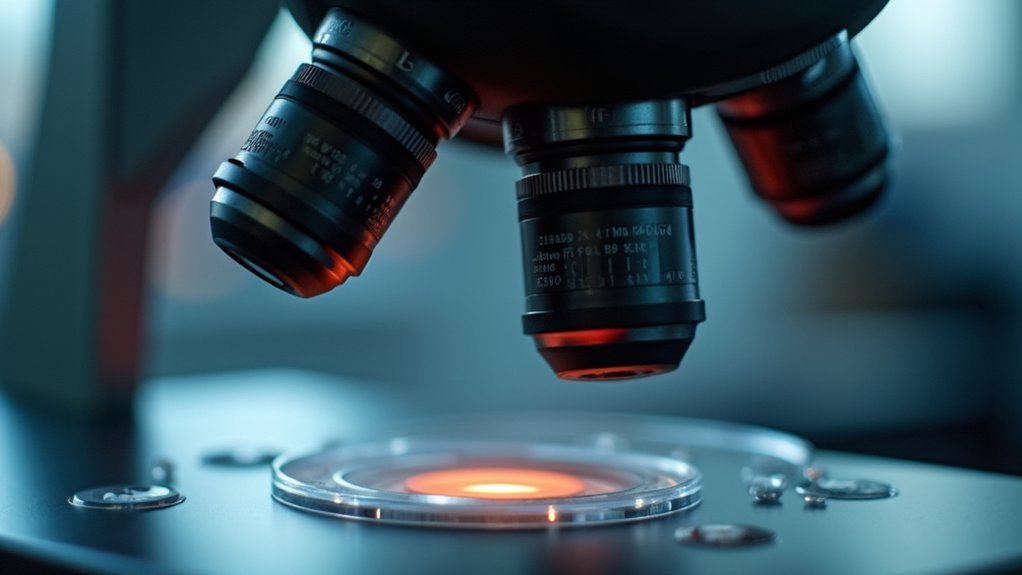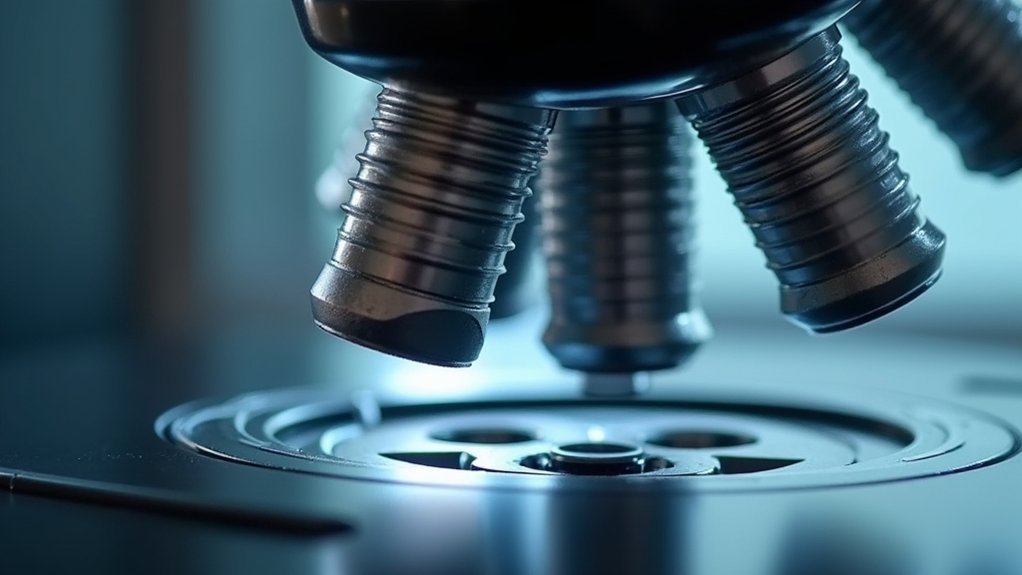To align phase contrast annuli correctly: 1) Prepare microscope with proper objectives and annuli, 2) Set up Köhler illumination, 3) Insert centering telescope into eyepiece port, 4) Identify bright condenser annulus and dark phase plate rings, 5) Use condenser centering screws to superimpose rings, 6) Verify alignment with a test specimen, 7) Repeat when switching objectives. Proper alignment guarantees crisp, high-contrast images of otherwise transparent specimens. The following steps reveal the precision techniques professionals use.
Gathering the Essential Equipment for Alignment

The successful alignment of phase contrast annuli begins with having the right equipment at your disposal. You’ll need a microscope equipped with a phase contrast condenser that corresponds to your contrast objectives. Make sure you have a 10x phase objective labeled “Ph1” and its matching phase annulus for best imaging results.
A centering telescope is essential for accurately aligning the phase annulus with the objective phase plate. This specialized tool allows you to visualize both components simultaneously during adjustment.
Before beginning the alignment process, set up proper Köhler illumination to establish even lighting conditions across your specimen.
Finally, locate the centering screws or adjustment knobs on your condenser. You’ll use these to make precise movements when centering the annulus during the alignment procedure.
Preparing Your Microscope for Phase Contrast
To align phase contrast annuli properly, you’ll need a complete alignment kit containing centering screws and a phase telescope.
Begin your setup by ensuring your microscope has both the appropriate phase objectives and matching condenser annuli installed in their correct positions.
Once your components are in place, check that your light source is centered and adjusted to appropriate intensity before proceeding to the actual alignment steps.
Essential Alignment Kit
Successful phase contrast microscopy begins with three essential components in your alignment kit: a properly equipped phase contrast microscope with centering telescope, a matching 10x phase objective (typically paired with a Ph1 annulus), and a correctly configured Köhler illumination system.
To properly align your phase contrast setup and achieve sharp contrast images:
- Verify your phase contrast microscope includes a phase contrast centering telescope, which is critical for visualizing the alignment position.
- Select the correct 10x phase objective and corresponding Ph1 annulus for maximum phase contrast imaging.
- Set up Köhler illumination before beginning the alignment process to distribute light evenly across your specimen.
- Locate the condenser centering screws to precisely align the annulus with the phase plate for artifact-free imaging.
Initial Component Setup
Before beginning the alignment process, you’ll need to prepare your microscope with the proper components for phase contrast imaging. Start by installing the correct phase objective lens and ensuring your condenser contains the appropriate phase annulus.
Set up Köhler illumination for even lighting across your field of view—this is critical for effective phase contrast. Once illumination is maximized, place your specimen securely on the stage, making sure it’s stable and properly positioned.
Next, remove one eyepiece and insert the centering telescope. This tool is essential to properly center and align the condenser annulus with the phase plate in the objective lens.
Through the telescope, you’ll see two rings that must be perfectly superimposed using the condenser’s centering screws for ideal contrast.
Inserting the Phase Telescope or Bertrand Lens

Once you’ve prepared your microscope for phase contrast imaging, you’ll need to insert the phase telescope or Bertrand lens to align the condenser annuli properly.
First, remove one eyepiece from the microscope’s ocular port to make room for the phase telescope.
When inserting the phase telescope, follow these steps:
- Orient the telescope correctly to view both the dark phase plate ring and the light condenser annulus ring.
- Adjust the telescope’s focus until both rings appear sharp and clearly defined.
- Use the centering screws on the condenser to move the light ring until it perfectly overlaps with the dark ring.
- After achieving proper alignment, remove the phase telescope and replace the eyepiece to resume specimen observation.
Identifying the Phase Plate and Annulus Rings
You’ll need to distinguish between the two key ring structures when aligning your phase contrast microscope: the bright annulus ring from the condenser appears as a luminous circle, while the darker phase plate ring in the objective has a distinctive shadowy appearance.
These rings have different sizes and intensities, with the annulus typically appearing brighter and the phase plate showing as a darker band when viewed through the centering telescope.
Learning to visually differentiate between these structures is essential for achieving proper alignment, as their perfect superimposition creates the ideal conditions for phase contrast imaging.
Recognizing Ring Structures
Successful phase contrast microscopy hinges on your ability to identify and distinguish between two critical ring structures in your optical system.
When you look through the eyepiece, you’ll observe two distinct rings that must be properly aligned for ideal phase contrast imaging.
- Light ring – This is the condenser annulus, characterized by its sharp, defined edge and located in the condenser.
- Dark ring – This is the objective phase plate, positioned at the rear focal plane of the objective lens.
- Perfect overlap – When properly aligned, these rings should perfectly coincide, indicating correct centering.
- Observation tools – A centering telescope helps you focus on both rings simultaneously, making alignment considerably easier.
Visual Differentiation Techniques
When looking through your microscope’s eyepiece, distinguishing between the phase plate and annulus rings becomes critical for proper alignment. You’ll see the phase plate as a clear ring surrounded by the darker annulus ring when properly positioned in the image plane.
| Feature | Identification Tip |
|---|---|
| Phase Plate | Clear ring in objective rear focal plane |
| Annulus | Dark ring in condenser’s lower lens |
| Ideal View | Remove specimen from light path |
| Alignment Check | Use centering telescope to focus both rings |
| Adjustment | Use centering screws for perfect overlap |
For the clearest phase contrast images, remove your specimen temporarily while aligning. This allows you to see both structures without interference. Then use the centering screws to adjust the annulus until it perfectly overlaps with the phase plate, ensuring ideal contrast when viewing your specimens.
Centering the Annulus Using Adjustment Screws

Precise alignment of the phase contrast annulus requires careful manipulation of the centering adjustment screws on your condenser.
These specialized screws allow you to precisely align the phase rings with your objective’s phase plate, ensuring maximum contrast and image quality.
To properly center your annulus:
- Focus on your specimen with the phase objective in the viewing position.
- Insert the centering telescope in place of your regular eyepiece.
- Locate the adjustment screws on the condenser annulus and make small, incremental turns while observing the rings.
- Adjust until the light and dark rings appear perfectly concentric.
Once you’ve achieved proper alignment, replace the centering telescope with your regular eyepiece and verify that your specimen appears with enhanced clarity and contrast.
Verifying Alignment With a Test Specimen
After you’ve completed the mechanical alignment using the centering telescope, you’ll need to confirm your adjustments work in practice.
Place a phase contrast test slide on the stage and examine the specimen under your microscope. Properly aligned phase rings will produce clear images with distinct contrast and no halos around object details.
Adjust your light intensity to optimize visibility—too bright or dim lighting can mask alignment issues. If you notice poor contrast or artifacts, return to the centering telescope and recheck the alignment of your phase rings, making certain they overlap perfectly.
Make verification with test specimens part of your regular microscope maintenance routine, especially after any adjustments to your contrast technique.
This practice guarantees consistent, high-quality imaging and reliable results from your phase contrast system.
Maintaining Alignment Across Different Objectives

Each time you switch between phase contrast objectives, you’ll need to realign your phase annuli to maintain excellent image quality.
Remember that each objective has its own dedicated phase ring that must be correctly aligned with the corresponding condenser annulus.
To guarantee consistent results across objectives:
- Adjust the substage condenser centering screws for each objective individually.
- Verify that the annulus to align precisely matches the phase ring in the rear focal plane.
- Check alignment using the telescope or Bertrand lens after every objective change.
- Re-center immediately if you notice any misalignment to prevent contrast degradation.
This recalibration process is essential because each objective’s optical design may require unique adjustments, making sure you’ll always achieve superior image quality and consistent contrast.
Frequently Asked Questions
How to Align Phase Contrast?
You’ll need to insert a centering telescope, adjust the condenser screws until the dark and light rings overlap perfectly, then remove the telescope and verify alignment with test slides.
What Is the Phase Contrast Annular Diaphragm?
The phase contrast annular diaphragm is a ring-shaped aperture you’ll find under your microscope’s condenser. It creates a hollow cone of light that interacts with the phase plate in your objective lens, enhancing transparent specimen visibility.
What Is the Phase Contrast Microscope Procedure?
You’ll set up Köhler illumination, place your specimen, use the centering telescope to align condenser annulus with phase plate rings, replace the eyepiece, and open the condenser diaphragm for ideal phase contrast imaging.
How Do You Prepare for a Phase Contrast Slide?
To prepare a phase contrast slide, you’ll need to mount your thin specimen on a clean slide, add a coverslip, and guarantee minimal thickness. Don’t use stains as they’d interfere with the natural phase differences.
In Summary
You’ve successfully aligned your phase contrast microscope by following these seven straightforward steps. With properly centered annuli, you’ll now enjoy crisp, high-contrast images of transparent specimens. Remember to check your alignment periodically, especially when switching between objectives. This simple maintenance routine you’ve learned will consistently deliver the exceptional image quality that’s essential for your scientific observations and documentation.





Leave a Reply